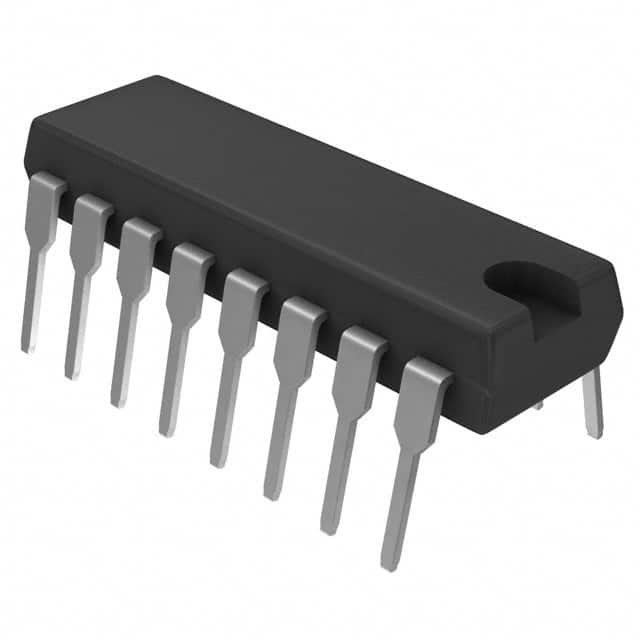Xem thông số kỹ thuật để biết chi tiết sản phẩm.

MAX232N
Product Overview
- Category: Integrated Circuit (IC)
- Use: Level translator and RS-232 driver/receiver
- Characteristics: Low-power, dual-channel, RS-232 transceiver
- Package: DIP (Dual In-line Package) or SOIC (Small Outline Integrated Circuit)
- Essence: Converts signals between RS-232 voltage levels and TTL/CMOS logic levels
- Packaging/Quantity: Available in tubes or reels, quantity varies by manufacturer
Specifications
- Supply Voltage: 4.5V to 5.5V
- Data Rate: Up to 120kbps
- Number of Channels: 2
- Operating Temperature Range: -40°C to +85°C
- Input Logic Levels: TTL/CMOS compatible
- Output Logic Levels: RS-232 compliant
Pin Configuration
The MAX232N has a total of 16 pins, which are divided into two sections:
Section 1: Channel A
- VCC - Positive power supply
- C1+ - Capacitor connection for charge pump 1
- C1- - Capacitor connection for charge pump 1
- GND - Ground reference
- T1OUT - Transmitter output for channel A
- R1IN - Receiver input for channel A
- R1OUT - Receiver output for channel A
- T1IN - Transmitter input for channel A
Section 2: Channel B
- T2IN - Transmitter input for channel B
- R2OUT - Receiver output for channel B
- R2IN - Receiver input for channel B
- T2OUT - Transmitter output for channel B
- C2- - Capacitor connection for charge pump 2
- C2+ - Capacitor connection for charge pump 2
- GND - Ground reference
- VCC - Positive power supply
Functional Features
- Provides voltage level translation between RS-232 and TTL/CMOS logic levels
- Allows direct interfacing of microcontrollers or other logic devices with RS-232 devices
- Eliminates the need for external components such as voltage level shifters or inverters
- Supports full-duplex communication with two independent channels
Advantages and Disadvantages
Advantages
- Low-power consumption
- Wide operating temperature range
- Easy to use and integrate into existing designs
- Cost-effective solution for RS-232 communication
Disadvantages
- Limited data rate compared to newer ICs
- Requires external capacitors for charge pump operation
- Not suitable for high-speed applications above 120kbps
Working Principles
The MAX232N utilizes a charge pump circuit to generate the necessary RS-232 voltage levels from the lower TTL/CMOS logic levels. It consists of two charge pumps, one for each channel, which convert the positive and negative supply voltages into RS-232 voltage levels.
When a logic high is applied to the transmitter input, the charge pump generates a positive voltage on the corresponding transmitter output pin. Conversely, when a logic low is applied, the charge pump generates a negative voltage. This allows bidirectional communication between the microcontroller and the RS-232 device.
Application Field Plans
The MAX232N is commonly used in various applications that require RS-232 communication, including:
- Serial communication interfaces for microcontrollers and embedded systems
- PC-to-peripheral communication (e.g., printers, modems)
- Industrial automation and control systems
- Networking equipment (routers, switches)
- Test and measurement instruments
Alternative Models
There are several alternative models available that offer similar functionality to the MAX232N. Some popular alternatives include:
- MAX3232: Improved version with higher data rates and lower supply voltage requirements
- MAX202: Low-power RS-232 transceiver with integrated charge pump
- LTC1480: High-speed, low-power RS-232 transceiver with shutdown mode
These alternative models can be considered based on specific application requirements and desired features.
In conclusion, the MAX232N is a widely used IC for level translation and RS-232 communication. Its low-power consumption, ease of use, and cost-effectiveness make it a popular choice in various industries. However, its limited data rate and external capacitor requirement should be taken into consideration when selecting this IC for high-speed applications.
Liệt kê 10 câu hỏi và câu trả lời thường gặp liên quan đến ứng dụng MAX232N trong giải pháp kỹ thuật
Sure! Here are 10 common questions and answers related to the application of MAX232N:
Q: What is MAX232N?
A: MAX232N is a popular integrated circuit (IC) used for converting signals between RS-232 voltage levels and TTL/CMOS logic levels.Q: What is the purpose of using MAX232N?
A: The main purpose of using MAX232N is to enable communication between devices that operate at different voltage levels, such as connecting a microcontroller to a computer's serial port.Q: How does MAX232N work?
A: MAX232N uses charge pumps to generate the necessary voltage levels required for RS-232 communication, allowing bidirectional data transfer between devices.Q: Can I use MAX232N with both 3.3V and 5V systems?
A: Yes, MAX232N can be used with both 3.3V and 5V systems as it supports a wide range of input and output voltage levels.Q: How many RS-232 channels can MAX232N support?
A: MAX232N typically supports two RS-232 channels, allowing you to connect two devices simultaneously.Q: What is the maximum data rate supported by MAX232N?
A: The maximum data rate supported by MAX232N is typically around 120 kbps, but it can vary depending on the specific implementation.Q: Do I need external capacitors for MAX232N?
A: Yes, MAX232N requires external capacitors to stabilize its charge pump circuits. The datasheet provides recommended values for these capacitors.Q: Can I use MAX232N in battery-powered applications?
A: Yes, MAX232N can be used in battery-powered applications as it has low power consumption and operates within a wide supply voltage range.Q: Can I use MAX232N for long-distance communication?
A: MAX232N is primarily designed for short-distance communication (up to 15 meters). For longer distances, additional line drivers or repeaters may be required.Q: Are there any alternatives to MAX232N?
A: Yes, there are alternative ICs available, such as MAX3232, which offer similar functionality but with lower power consumption and higher data rates.
Please note that these answers are general and may vary depending on the specific implementation and requirements of your technical solution.

